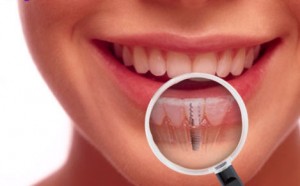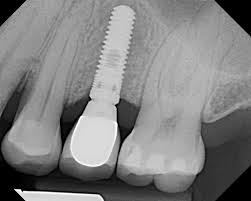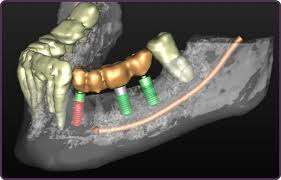



Dental
implants are changing the way people live. They are designed to
provide a foundation for replacement teeth which look, feel, and
function like natural teeth. The person who has lost teeth regains
the ability to eat virtually anything and can smile with
confidence, knowing that teeth appear natural and that facial
contours will be preserved.
The implants themselves are tiny titanium posts which are inserted
into the jawbone where teeth are missing. These metal
anchors act as tooth root substitutes. They are surgically placed
into the jaw bone. The bone bonds with the titanium, creating a
strong foundation for artificial teeth. Small posts are then
attached to the implant which protrude through the gums. These
posts provide stable anchors for artificial replacement teeth.
Implants also help preserve facial structure, preventing the bone
deterioration which occurs when teeth are missing.
For most
patients, the placement of dental implants involves two surgical
procedures, although in individual cases one stage surgery may be
feasible. First, implants are placed within your jawbone. For
the first three to six months following surgery, the implants are
beneath the surface of the gums gradually bonding with the
jawbone. You should be able to wear temporary dentures and eat a
soft diet during this time. At the same time, your dentist is
making new replacement teeth.
After the implant has bonded to the
jawbone, the second phase begins.The surgeon will uncover the
implants and attach small posts which will act as anchors for the
artificial teeth. These posts protrude through the gums. When the
artificial teeth are placed these posts will not be seen. The
entire procedure usually takes six to eight months.
Over a period of time, the jaw bone
associated with missing teeth may atrophy or be reabsorbed. This
often leaves a condition in which there is poor quality and
quantity of bone suitable for placement of dental implants. In
these situations, patients may not be candidates for placement
of dental implants.
We now have the ability to grow bone where
needed. This not only gives us the opportunity to place
implants of proper length and width, it also gives us a chance
to restore functionality and esthetic appearance.
These procedures may be performed
separately or together, depending upon the individual's
condition. Whilst we mostly uses an artificial bone material
(bone subsitute), there are several areas of the body which are
suitable for attaining bone grafts. In the maxillofacial
region, bone grafts can be taken from inside the mouth, in the
area of the chin or third molar region or in the upper jaw
behind the last tooth. In more extensive situations, a greater
quantity of bone can be attained from the hip.
Additional procedures may sometimes also be required
including:Sinus lift procedure
This procedure involves elevating the sinus
membrane and placing the bone graft onto the sinus floor,
allowing implants to be placed in the back part of the upper
jaw
Ridge-augmentation
In severe cases the ridge has been
reabsorbed and a bone graft is placed to increase the ridge
height and/or width.
Nerve- repositioning
The inferior aveolar nerve, which gives
feeling to the lower lip and chin, may need to be moved in
order to make room for placement of dental implants to the
lower jaw.




